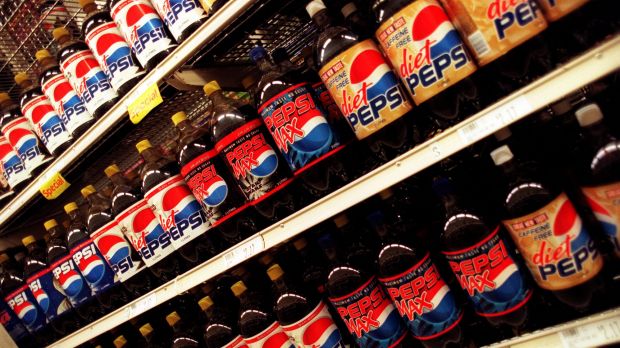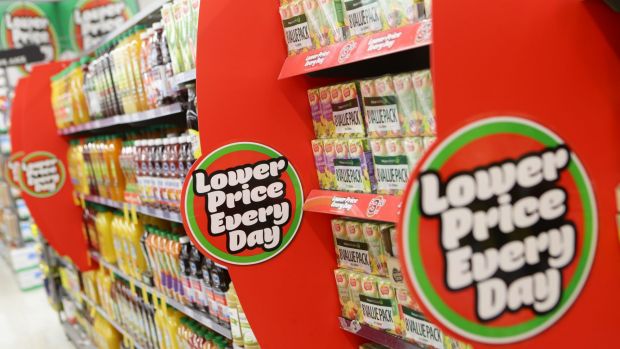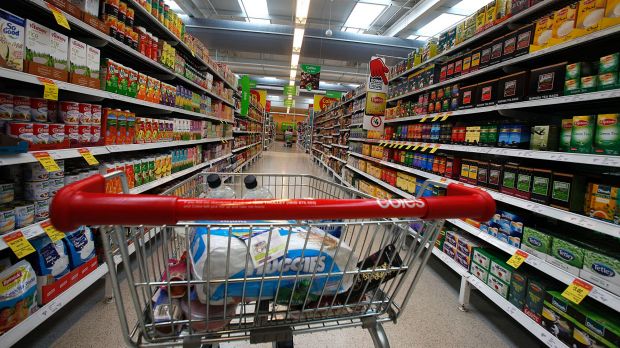If there's one thing you can just about bank on for Australia Day, it's a supermarket price war.
Coles fired the first salvo six years ago, sparking the "milk wars" by launching its controversial $1 litre campaign on January 26, 2011. Last year, Coles again used the national holiday to launch its $8 price on barbecue chickens, and once again it caught rival Woolworths napping with the price drop.
More BusinessDay Videos
Supermarket results: Woolworths could win sales race
Fairfax's Catie Low explains predictions that Woolworths will shake off its 29-quarter losing streak to win the second quarter sales race.
Whether or not Coles will capture the hearts and wallets of consumers with this year's campaign – it has chosen cheap, low-grade mince meat as its preferred battle ground – remains to be seen.
But what is becoming increasingly clear is the war in the aisles is taking its toll on the bottom line for Australia's two largest supermarkets chains.
Fairfax Media has obtained confidential supermarket scan data compiled by global market intelligence company IRi that illustrates just how dire the outlook might be for the Australian grocery sector, and how aggressive discounting has pushed Coles and Woolworths down a road of mutual profit destruction.
To see where the major supermarkets are failing only takes a glimpse at the areas where they are succeeding. According to that IRi data, pharmacy sales, alcohol and convenience sales were among the few bright spots for supermarkets last financial year.
Just the medicine

Pharmacy sales were the stand-out, up 10.1 per cent last financial year. According to IRi's report, that figure was "heavily skewed by strong ranging in categories benefiting from the surge in overseas export demand – most notably infant formula and vitamins and minerals".
In other words, the Chinese rush for Australian infant formula has helped to cushion the blow for the major retailers in other parts of the supermarket aisles. The Chinese daigou, or "grey market" resellers, have driven demand for baby formula and provided the biggest growth category for Coles and Woolworths. It also explains why both major retailers quietly removed or lifted tin limits on infant formula during 2016.
The second biggest growth area was convenience, up 4.1 per cent year-on-year. That figure, according to IRI's report,is being "propelled by tobacco" with increased federal government taxes lifting total turnover. But the supermarkets act as little more than a tax collection point for government in the tobacco market, with little if any earnings for the retailer coming from those price rises.
That leaves increased liquor sales, up 3.6 per cent, as the last beacon of good news for the supermarkets. That figure, again, seems to be propelled by a short-term fad. According to IRi, the lift was driven by "drinkers continuing to embrace beers that command a price premium above the category average in the craft and low-carb beer markets".
Every time you take something down in price, what you say to your customer is this was too expensive previously and they wait for you to do it again.
Former Woolworths boss Roger Corbett.
It was enough for one industry veteran to declare it a "hipster and daigou-led recovery" after reading the report.
"Bet they won't tell shareholders that at the next Woolies AGM," he quipped.
It might be a joke, but he's not too far from the truth. All that was missed was the boom in infant formula.
Weak growth

According to the IRi data, Australia's grocery spend last financial year was $59.4 billion, up 0.9 per cent on the previous financial year. When you strip out tobacco and baby needs, that figure falls to $48.3 billion, and was up just 0.3 per cent on the previous financial year.
That means the value of supermarket sales, with the growth in cigarette prices and surging demand for infant formula is stripped out, was well below Australia's historically low inflation rate last financial year.
In the context of increases in major fixed costs, such as power, property charges and labour, Australia's supermarket chains went backwards, raising serious questions about the investment case for grocery in Australia as well as the sustainability of Coles and Woolies' internecine price war.
But the reliance on beer, babies and smokes for revenue growth can be seen another way.
Out of every $6 spent by Australians and daigou buyers in major supermarkets last year, more than $1 went on tobacco or baby needs. When you add the estimated $16.2 billion turnover of Australia's packaged liquor retail industry to the supermarket grocery spend, then $1 in every $3 goes on either booze, smokes or baby needs.
"Look outside of that universe, and the news is pretty bleak for the big two retailers," the industry veteran told Fairfax Media.
No sweet spot

IRi's data outside of that "universe" certainly does paint a bleak picture for Coles and Woolworths. Of the 182 categories of grocery products across supermarket shelves, 91 are now considered "growth drainers", with year-on-year sales in decline.
A consumer backlash against sugar in foods has played a major part in this. Seven of the top 12 growth drainers contain sugar. Worst of all is soft drink sales – for years a driver of promotional discounts and foot traffic for the big supermarkets – which have accounted for 21.7 per cent of the value of all declines, the "drainage", across those 91 grocery segments, according to the IRi data.
Australia's supermarkets aren't feeling anything other western countries aren't also experiencing. In Britain – where Australia's supermarkets constantly cast their gaze for both strategy inspiration and the executives to implement it – price deflation across the aisles has been evident since 2014.
The annual "fast moving consumer goods basket", or "FDCG" as the retail analysts like to call it, fell from £10,889 in 2014 to £10,551 last financial year for "all items across all baskets".
It's the same story in the US and Australia. Supermarkets are cutting costs, shifting to private labels and cutting their ranges.
Globally, IRi has warned that those discounts come at a cost to margins, and do not guarantee the supermarkets either loyalty or market share.
"Question marks do exist around the long-term effectiveness of deeply promoted products," warns IRi. "While promotions might drive short-term volume uplift, it can also become a source of price distrust."
Rivals loom

Amid a strategy that seems to be playing into the hands of ALDI and Costco, IRi warns that Australian consumers are becoming increasingly "promotion loyal rather than brand loyal".
One experienced retailer, who would only speak on the basis of anonymity, said both Coles and Woolworths knew that price-cutting was "unsustainable", and both were working on "alternative plans".
It's a view shared by many of the leading retail analysts, who point to Woolworths chief Brad Banducci's $1 billion investment in slashing prices to explain a feeble growth result last financial year. They say it also underlines the downside of aggressive pricing for both brands.
To understand how Coles and Woolworths drove the growth of grocery sales to the brink of negative territory, analysts point to Australia Day last year, and Coles' launch of its discount price on chickens.
Within days of slashing the price of barbecue chickens from $11 to $8 Woolworths also cut the price of its cooked chooks to $7.90, undercutting Coles by a further 10 cents, despite not having the supply chain support in place to match the increased demand.
This inevitably led to in-store shortages and annoyed and disappointed the very customers Woolworths claimed it working so hard to win back.
Cutting themselves

It's the precise cost-cutting death spiral that IRi and analysts have warned about, but that wasn't the point, according to industry watchers. There was a message that came with each of Woolworths cut-price chickens, and it was specially meant for Coles boss John Durkan.
"What this said to Coles was 'you are a one-trick pony and you are going to have to find something else'," said one leading analyst.
What the barbecue chicken war conveyed was a shift in Woolworths' strategy, and a signal that it was prepared to match Coles on major promotions. Given the fresh assault with mince meat this Australia Day, it seems the message wasn't take on board.
Woolworths now chief executive Brad Banducci was the boss of the chain's supermarkets division on Australia Day last year. One month later, he was anointed the new chief executive of the company.
Chairman Gordon Cairns had already drawn a line under the monstrous losses from Woolworths' failed assault on hardware behemoth Bunnings. That misadventure with Masters cost the "Fresh Food People" their market leadership and provided an opportunity for Coles to build an imposing lead.
Insiders tell Fairfax Media that Cairns gave Banducci "free rein" to get Woolies back on track and back into contention with Coles, as well as discount leader ALDI, which has built a loyal following while Woolworths was busy losing the hardware war. Banducci was given a year, one source claims, along with whatever resources he needed to make Woolies great again.
Enormous bill

Woolworths' CEO Brad Banducci. Photo: Louie Douvis
Insiders claim he "threw the kitchen sink at it", but there was a big cost. The bill was enormous. Banducci spent $1 billion to get prices down and, along the way, it appears he's driven price deflation to new lows and revealed how easily these two giants of Australian retail could descend into a mutually destructive fight.
Last financial year prices were down 1.7 per cent at Coles, 2.2 per cent at Metcash/IGA, and 2.4 per cent at Woolworths.
Banducci himself has defended the investment in lower prices, in light of IRi's report stating that discounts discourage loyalty
"Woolworths is very focused on building trust with our customers," he told Fairfax Media.
"The way we build trust is to put customers first and to do the right thing.
"We aim to have a good balance of promotional and everyday low prices across the store. We're especially working hard to have a good mix across everyday essentials.
He added: "We are on a journey and our customer feedback shows that we're heading in the right direction".
The core problem for both Coles and Woolies is that, while discounting wins over customers in the short term, it's not a sustainable business strategy, and that's troubling news for shareholders, the other big stakeholder in both these brands.
Back in June last year Wesfarmers hosted a strategy briefing day to share details of its plan for each of the operations that make up the conglomerate, including Coles. The supermarket's earnings accounted for more than half of Wesfarmer's group earnings last financial year and inquiries about the chain dominate investor forums.
At the investor briefing, outspoken Merrill Lynch analyst David Errington congratulated Coles boss John Durkan on the performance of Coles, which he said made him want to shop at the chain, but he was less sure he wanted to be a shareholder in the business.
Errington said the intense focus on price was great for shoppers, but it was less clear how this strategy was going to improve shareholder returns.
Durkan responded by saying the discounting in supermarkets in Australia remained "rational" and Australia's thriving independent fresh sector – shoppers going to local butchers, green grocers and fishmongers – revealed there were plenty of opportunities to grow the Coles customer base and drive new sales.
Woolworths massive spend on cutting prices and Coles' ongoing reliance on promotions such as barbecue chickens, lamb roasts and $1 milk has cut the ground from beneath both these brands and suppliers, investors and analysts fear they are hurtling headlong into a downward spiral.
Promotion driven

Former Woolworths boss Roger Corbett would not comment on any aspect of Woolworths' current business, but he claims the basic lack of confidence in the Australian business sector was a serious issue for the country's grocery sector, which was crying out for some serious investment.
Corbett urged the country's major retailers to invest in efficiencies such as better supply chain operations, and move away from their heavy reliance on promotions.
"The Australian supermarket industry over the last 10 years has significantly lifted its gross margins and let its cost go up, so it's now highly promotionally-driven with 50 or 60 per cent of the market sold off price," Corbett says.
"That affects the relationship between suppliers and retailers but it also creates a situation where more and more people wait for merchandise to be off price."
The IRI data reveals that the situation isn't quite as bad as Corbett claims. Last year one-third of all grocery items were sold on a promotional discount of 10 per cent or above. But that figure rises above 50 per cent in 15 key grocery categories, including snacking chips, confectionery and biscuits.
Corbett says around the world discount operators such as Aldi and Costco prosper when the major retailers give it the "opening price point."
"To sustain a higher and higher promotional program, the major supermarkets abandoned meeting Aldi's opening price point, which gave it an immense advantage in the lower part of the market so they've gained an enormous stronghold in the Australian market."
Productivity push

He says what the grocery sector should have focused on productivity lowering costs but instead their margins and their costs have gone up.
"If you have a promotional program, where particular items are going up and down then you greatly, adversely affect the cost of your distribution and you get big blocks of stock going in and out and that's exactly what you don't want, you want continuity," says Corbett.
"Every time you take something down in price, what you say to your customer is this was too expensive previously and they wait for you to do it again."
PricewaterhouseCoopers global retail adviser and former David Jones boss Paul Zahra says price is still the most influential determinant for grocery purchases in Australia with convenience and range ranking second and third in the hierarchy.
"The supermarket industry is one of the most fiercely competitive industries and it's only getting more competitive," Zahra says.
"In a business where prices are coming down, the margins are in fact reducing in many cases because they're on a lower price it's hard to get growth if you're reducing prices on grocery – you've got to work twice as hard to get into the growth stage.
"It's a dangerous spiral, which is why supermarkets are now focused on private label because they believe they've got a better change of managing their destiny with that."
He says supermarkets are also cutting their ranges with Coles announcing plans to cut product lines by as much as 15 per cent to drive efficiency savings across its store network.
Weakening growth

At the release of Coles' first quarter sales results in late October, Durkan claimed grocery market sales were weakening after posting a worse-than-expected growth rate.
And Wesfarmers chief Richard Goyder is believed to have been softening-up investors for the likelihood that Woolworths will push ahead of its second quarter like-for-like sales growth result, ending a 29 quarter losing streak for the retailer.
Winning the quarter will provide a confidence boost for Woolworths' management team but it's early days in the turnaround story and analysts warn Banducci doesn't have another $1 billion to sink into prices. And even if he did, price alone isn't the answer amid fears grocery pricing could get "irrational."
Credit Suisse analyst Grant Saligari warned irrational pricing could emerge if Woolworths engaged in "overly aggressive price action."
"The risk of a period of pricing that would be damaging to profitability is likely to be higher in 2017 than prior years due to the improved performance of Woolworths," Saligari says.
Another experienced retailers says that supermarkets will need to find new ways to expand margins "like recipe boxes".
"It's going to require different thinking and that's probably going to require new people and new strategies. At some point there has to be a change in dynamic," he says.
Sadly for shareholders, that change in dynamic looks a long way off.
Already 2017 has heralded another Australia Day price war and another imported UK executive, after Woolworths tapped Tesco executive Claire Peters to lead its supermarkets.
It seems consumers are also set for another year of discounts "everyday low prices", which are increasingly alienating suppliers.
Amid this backdrop, chatter about Amazon has bubbled to the surface. Coles and Woolworths will need to apply their thinking to how a digital disrupter such as Amazon could cut a swathe through their grocery sales and decimate their shrinking market share.
In that world, discount mince meat might be more metaphorical than material when considering the future of the major supermarkets.
















6 comments
New User? Sign up